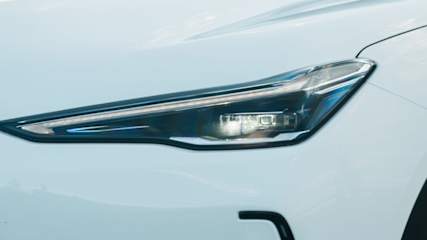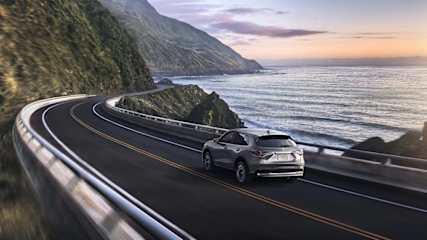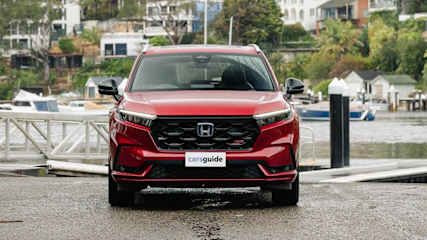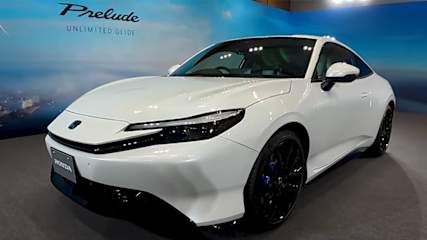Honda Concerto Reviews
You'll find all our Honda Concerto reviews right here. Honda Concerto prices range from $2,420 for the Concerto Ex I to $3,850 for the Concerto Ex I.
Our reviews offer detailed analysis of the 's features, design, practicality, fuel consumption, engine and transmission, safety, ownership and what it's like to drive.
The most recent reviews sit up the top of the page, but if you're looking for an older model year or shopping for a used car, scroll down to find Honda dating back as far as 1988.
Or, if you just want to read the latest news about the Honda Concerto, you'll find it all here.
Honda Reviews and News
 (3).jpg)
Electric car disaster! Why the much hyped solid-state battery might not cure all electric car problems and why it won't find its way into affordable EVs such as the 2026 Tesla Model Y, BYD Sealion 7 and Kia EV5
Read the article
By Dom Tripolone · 21 Jul 2025
Solid state batteries, the 'holy grail' of EV tech, continues to hit hurdles.

Save thousands with these new car deals: All the end of financial year deals from car brands in Australia
Read the article
By Jack Quick · 01 Jun 2025
It’s EOFY time again!

Stylish family SUV updated: 2026 Honda ZR-V gains cosmetic and tech upgrades to chase the Toyota Corolla Cross, Mazda CX-30 and Nissan Qashqai
Read the article
By Samuel Irvine · 22 May 2025
Honda has updated its popular ZR-V SUV in the US, granting it a host of cosmetic and tech upgrades.

The future is hybrid: Honda to launch 13 new hybrid cars by 2027 to battle Toyota as it backtracks on electric car plans after failed Nissan merger
Read the article
By Samuel Irvine · 21 May 2025
Honda has become the latest global automaker to revise its electrification plans by announcing it will reduce its investments in electric vehicles (EVs) and instead prioritise advancements in its hybrid technology.Japan’s second-largest carmaker said it doesn’t expect to meet its aim of having EVs account for 30 per cent of its global sales by 2030, citing uncertainty in the global car market. The brand will subsequently reduce its investment in the powertrain technology by 30 per cent to seven trillion yen (A$75 billion) by fiscal year 2031.It does see significant growth in hybrid vehicles, with the brand targeting a 2.2 million hybrid sales by 2030, which would equate to roughly 61 per cent of the 3.6 million sales it recorded last year.Hybrids accounted for about 23 per cent of Honda’s global sales last year.To meet this ambitious target, Honda will bring 13 new hybrid models to the market from 2027 over a four-year period, with the US, the brand’s largest market by far, flagged as its major battleground.These new models are expected to run on Honda’s current two-motor hybrid or e:HEV system, which it said will advance through a newly-developed electric AWD drive unit and weight reductions to realise the “world’s most efficient powertrain”.Honda claimed fuel economy will subsequently improve on its e:HEV models by “more than” 10 per cent over where they stand currently, suggesting a Honda Civic e:HEV LS, the brand’s most fuel-efficient model in its Australian line-up, will see its fuel consumption fall below 4.0-litres/100km.Honda said it will pursue advances in its hybrid powertrain without major additional financial investments in the technology, instead favouring cost reductions by pursuing production efficiency and the “commonisation” of more key parts and components with suppliers.Despite the reduced investment in EVs, the 0 Series electric saloon and SUV models, which were teased in concept guise earlier this year, will remain a major part of the brand’s electrification strategy and remain on track for release next year.They, along with Honda’s future hybrid models, will feature the brand’s next-generation Advanced Driver Assistance Systems (ADAS), which are poised to incorporate Level 3 autonomous-driving capabilities.Honda’s decision to revise its electrification plans comes following the collapse of a proposed merger with Nissan this February, which would have created the world’s second largest car brand, behind Japanese rival Toyota.Talks broke down after it was reported that Nissan did not want to be a Honda subsidiary.Nissan, which sold half a million fewer cars than Honda last year, reported a $7 billion net loss in the 12 months to March 2025, leading it to announce 20,000 job cuts and seven factory closures. Nissan has now similarly shifted its focus to more hybrid vehicles.Honda currently sells five hybrid models in Australia: Accord, Civic, CR-V, ZR-V and HR-V.The brand has sold 5331 cars as of April this year in Australia, 9.2 per cent fewer than the same period last year, in what is a small fraction of its global sales.

Why size doesn't matter when it comes to the price of a car | Opinion
Read the article
By Tim Nicholson · 08 May 2025
Does size matter? It’s an age-old question but when it comes to cars, it’s complicated.Most car reviews - rightly - will cover whether the model represents good value for money. That will usually include a focus on what is and isn’t included in the standard features list, the safety offering, quality of materials and more.Often this will include whether you get enough metal for your money. Is the car big enough for the price?My question is, should size factor into the value of a car? And how do you fairly determine value when each buyer has a different budget?I understand that everyone has different requirements when looking for a new car. A family of five will require more space than a family of two, or a single person, for example.But I would argue that size should not determine whether a car represents good or bad value for money.Again, I appreciate that many people will want as much car as they can get for their money, based on how they will use it. But surely things like overall vehicle quality, the drive experience and how the car makes you feel are just as important.Here’s an example. A Honda Civic e:HEV L costs $49,900 (drive-away). When compared with old foes like the Mazda3 and Toyota Corolla, it is seen as being quite a lot of money for a small hatchback.For roughly the same price as the Civic, you could buy an entry grade large seven-seat SUV like a Kia Sorento, Hyundai Santa Fe, Isuzu MU-X, or a Toyota Kluger.But just because you can get a bigger car for the same price, should you?If you don’t need the space, then I say you shouldn’t. And not just for reasons like the environmental impact of large vehicles, or the sheer space it takes up on the road. Although those reasons are also valid.If a smaller car ticks other boxes including being fun to drive, that should be enough.Back to my example - the Honda Civic hybrid is an excellent car. I would argue it’s the best small passenger car (as in, not an SUV) on sale in Australia. It has excellent build quality, a solid standard features list, a handsome design, nicely executed interior and an exceptional and efficient powertrain.Something like that is a perfect car for me. And I don’t feel like I would be ripped off buying this instead of a larger car.Similarly, if someone has the means to buy a premium car instead of something from a mainstream brand, that’s fine. As Donna Meagle famously said in Parks and Recreation, “Treat yo’self!”Sure, a circa-$60,000 BMW 120 hatch may not have the same level of standard features as a higher grade Toyota Corolla or Mazda3 - which cost $20,000 less - but who cares?If you have your heart set on a premium car like a BMW and you’ve got the money for it, then it doesn’t matter if it’s missing a few features.Whether it’s the materials in the cabin, the way it drives or the feeling you get when driving a premium European car, a model like that often just feels more special.A couple of years back I lived with a Peugeot 308 Premium GT hatchback for four months. That specific grade at the time was priced at $48,990 before on-road costs. Again, there was a lot of commentary about that being a lot of money “for a small hatchback”.I am not suggesting it’s cheap - it clearly isn’t. But that is an excellent little car that made me smile every time I got behind the wheel. I would be happy - proud even - to own one.To reiterate, there is nothing wrong with trying to get as much car as possible for your budget. If you want as many standard features as you can possibly get for $40k, and you are less fussed about how the car drives or its perceived quality, terrific. And there’s no shortage of options, especially with the growing number of Chinese brands offering affordable models.But equally, no one should be shamed for spending big bucks on a car that isn’t the size of a boat, or if it doesn’t tick every single box on the standard features list.

Is brand loyalty a thing of the past in the Australian new vehicle market? Why the new wave of challenger brands like MG, BYD and GWM will detach an increasing number of buyers from their long-term favourites | Opinion
Read the article
By James Cleary · 27 Apr 2025
In 2025 branding means way more than a hot iron mark scorched into a steer’s backside.It’s about a brand’s personality, reputation and your interactions with it. What it says about you. What it delivers. How it makes you feel. A visual identity, a design style… and a million other things. And there are automotive brands in the Australian new-car market that have strategically built solid brand equity over many decades.Current market leader, Toyota began dipping its corporate toe into global export waters by shipping cars here in the late 1950s. And other Japanese makers like Honda, Mazda and Nissan followed it in conquering initial hesitancy by steadily investing in strong retail networks, pushing product improvement and focusing on a positive customer experience.Ford has built its global brand around everything from the Model T and its revolutionary assembly line to pumped up muscle cars and victory at Le Mans. While here it embedded itself in the local landscape via a manufacturing presence spanning close to a century and regular victory at Mount Panorama.And more recently, relative newcomers like Hyundai and Kia have moved rapidly from cheap and (mostly) cheerful to innovators that repositioned the concept of value and quality in the local market.All of which led to large pockets of ‘rusted on’ brand loyalty. The concept of ‘Ford and Holden families’ started to diminish from the moment the latter departed the scene in 2020 (if not before), but Toyota’s reputation for value, durability and affordable ownership has seen it maintain a legion of never-say-die fans.Same for Ford, Mazda, Mitsubishi and others. But I'd argue a turning point was when, after an initial false start through a private importer in 2013, MG set up as a direct subsidiary in 2017.Great Wall had landed as the first Chinese car brand in the Aussie market in 2009, but MG 2.0 was different. Even if its ‘Since 1924’ positioning stretched credulity, its products were better than expected and pricing was ultra sharp.Sharp enough to encourage budget-focused new-car buyers, even used-car prospects, to give the brand a go.With the introduction of new-generation products in the early 2020s sales took off like a rocket, and it’s here that my ‘That’s a good idea’ theory kicks in.I reckon executives at rival Chinese car brands, keeping an eye on MG’s increasing success Down Under, all had the same ‘good idea’ at the same time. Namely, let’s get into Australia and grab a piece of that action. Hence the subsequent arrival of Chery in 2023, itself a factory-backed restart after an initial import-distribution arrangement broke down back in 2011. Followed by the flood gates opening, with BYD, Deepal, Geely, a ramped up GWM, JAC, LDV, Leapmotor, Smart, Jaecoo, XPeng and Zeekr all jumping in with Aion, Avatar, Jetour, Lynk & Co, Skyworth and others waiting in the wings.Doesn’t matter which category you’re talking about - white goods, sporting equipment, hi-fi - if one fresh competitor enters a mature market, it’s likely to be met with reluctance, even contempt by existing brand loyalists.But if near enough to 20 newcomers blaze into market at the same time, clearly something seismic is going on and it feels like you’d be missing a trick if you didn’t at least investigate the rapidly changing competitive landscape.Give them the benefit of 20/20 hindsight as well as a time machine and it’s not certain all the new brands above would currently be making an Aussie entrance.But multiple triggers have been pulled with retail network deals done, head office staff recruited, parts warehousing set up, service and sales training completed and marketing campaigns launched. So, in a mature market, early movers like MG, Chery and GWM have the advantage and more recent arrivals will need to find a way to win over buyers… fast. And it’s a fair bet the ever-impactful lever marked price will be pulled on a regular basis.Some of the newcomers as well as more than a few existing legacy brands will be forced into a price war. Like it or not, loyalty comes under pressure when the incentive is enticing enough and with a cut-price cage fight likely to take place sooner rather than later not everyone will leave the octagon alive.Stand by for new-car buyers tempted en masse into ‘unbeatable deals’ that mean brand loyalties will be stretched beyond breaking point. The shake out from this looming war of attrition will be huge.

First look! Next-gen Honda Prelude's interior revealed but does it lack the sportiness of the Toyota 86 and Nissan Z?
Read the article
By Laura Berry · 03 Apr 2025
The interior of the eagerly awaited next-gen Honda Prelude has been revealed thanks to a Japanese YouTuber who has given us a glimpse into the cabin.When the Prelude concept made its debut in 2023 at the Tokyo mobility show it had blacked-out windows so the interior remained a mystery. It’s also highly unlikely it even had a finished interior at that point.Now thanks to Japanese YouTuber Unadon we’ve been given a guided tour inside the two-door 2+2 seater sports car and it's not quite as groundbreaking as we hoped.If anything the cabin, dashboard, controls and instruments are much the same as the cockpit in the current Honda Civic.Sure the new Prelude’s cabin is sporty and the two-tone sports seats with embossed Prelude headrests look modern and luxurious, but the climate control dials, honeycomb mesh air vents and steering wheel will all be familiar to anybody who has bought a Honda in the past few years.The rear seat is more or less a hard grey-coloured featureless bench without any form of obvious lateral support or even moulding for rear passengers.It’s unlikely the back seats will ever house the two people they’re designed to accommodate given the lack of space back there with the heavily sloped roofline and limited legroom. Unadon discovered how cramped it is when we ventured back there. There are also two ISOFIX points if child seats need to be installed.Unadon also gives us a look at the boot under the Prelude's liftback tailgate, revealing a small but deep area behind the rear seats that appears to be about 200 litres in capacity. He also folds the rear seats down to open up even more load carrying space.The Prelude, which is expected to make its European launch by the middle of 2025, will be hybrid only and use a petrol-electric system similar to the unit in the Civic. A manual transmission won't be available either.It's still not been confirmed for Australia, but our fingers are crossed.

Will your next Nissan or Mitsubishi electric car be built in Taiwan? How an iPhone manufacturer might help build a Japanese Tesla rival after failed Honda merger talks
Read the article
By Chris Thompson · 21 Mar 2025
In the weeks since Honda, Nissan and Mitsubishi ended talks to merge the three car brands into one conglomerate, a new player has entered the conversation.

Honda Civic 2025 review: e:HEV L
Read the article
By Andrew Chesterton · 19 Mar 2025
The Honda Civic is an all-hybrid affair in Australia - and it might be one of our absolute favourites. But there is one sizeable sticking point - its price.So, is the Civic e:HEV L worthy of its more-premium price tag? We put it to the test to find out.

Australia's best small cars
Read the article
By Stephen Ottley · 19 Mar 2025
In 2011 there was a seismic shift in the Australian car market - the Holden Commodore was dethroned as this country’s favourite car by the Mazda3.




